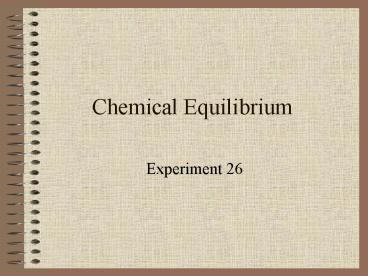Chemical Equilibrium - PowerPoint PPT Presentation
1 / 9
Title:
Chemical Equilibrium
Description:
The equilibrium constant, Keq, is the ratio of the ... The Spectrophotometer ... II, you will use a spectrophotometer to measure the % transmittance of mixtures ... – PowerPoint PPT presentation
Number of Views:100
Avg rating:3.0/5.0
Title: Chemical Equilibrium
1
Chemical Equilibrium
- Experiment 26
2
Chemical Equilibrium
- At the point of equilibrium, the concentrations
of all reactants remain constant with time. - At equilibrium, the original reaction is still
taking place but is opposed by the reverse
reaction. - The equilibrium constant, Keq, is the ratio of
the concentrations of all product species present
at the point of equilibrium to the concentrations
of all original reactant species.
3
The Equilibrium Constant
- For the general reaction,
- aA bB ?? cC dD
- The equilibrium constant will be,
- Keq CcDd / AaBb
4
The Spectrophotometer
- In choice II, you will use a spectrophotometer to
measure the transmittance of mixtures of ferric
nitrate and potassium thiocyanate at different
concentrations. - Using the equation for absorbance, A
-logT , and a calibration curve for the reaction,
you will be able determine the concentration of
your products.
5
Le Châteliers Principle
- Le Châteliers principle states that if we
disturb or stress a system that is already in
equilibrium, then the system will react so as to
minimize the effect of the disturbance.
6
Solubility Equilibria
- Suppose you have a saturated solution of sodium
chloride. - NaCl(s) ??Na(aq) Cl-(aq)
- If you added HCl, Cl-, the equilibrium would
shift to consume the added ion. - The equilibrium would shift to the reactants.
- This can be observed by the appearance of NaCl
precipitate.
7
Complex Ion Equilibria
- Remember from last week that metal ions will
react with certain substances to produce brightly
colored ions. - By monitoring the color of the solution you can
determine the position of equilibrium. - Fe3 SCN- ?? FeSCN2
- Yellow colorless
red - Using the equilibrium, you can add Fe 3 or SCN-
ions or remove SCN- ions and observe the effects
this has on the equilibrium.
8
Acid/Base Equilibria
- Many acids and bases, particularly weak ones,
exist in equilibrium like conditions. - For example, an aqueous solution of ammonia,
- NH3 H ?? NH4
- Using an acid-base indicator to observe pH
changes, you will add NH3 and H ions to see what
effects it has on the equilibrium.
9
Procedure Notes
- For choice II, make sure your test tubes, cuvets,
are clean and dry. - Use concentrated ammonia and hydrochloric acid in
the fume hoods only!!!!!!!!!!!!!!!!!!!!!!!!!!!!!!!
!!!!!!!































